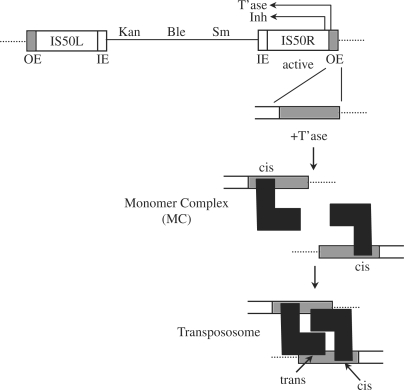Figure 1.
Structure of Tn5 and pathway for transpososome assembly. Tn5 is a 5.8 kb composite transposon encoding resistance to kanamycin (Kan), bleomycin (Ble) and streptomycin (Sm). These antibiotic resistance genes are flanked by nearly identical copies of the 1.5 kb IS50 insertion sequence. IS50R encodes functional transposase (T’ase) and inhibitor (Inh) proteins. Outside (OE) and inside (IE) sequences contain determinants for transposase binding and are shown as grey and white rectangles, respectively. Dotted line represents flanking donor DNA. A possible pathway for transpososome assembly is shown below the illustration of Tn5. An OE sequence is shown binding a single molecule of transposase (black L-shape) forming a monomer complex (MC). At this stage the transposase-OE contacts are defined as cis contacts. Subsequently, two MCs interact to form a transpososome. This interaction is driven by trans contacts between protein and DNA and protein–protein contacts. In an alternative model (not shown) transposase is transferred to a transposon end sequence in dimer form after initially pairing two non-transposon end DNA segments. The dimer-bound transposon end then captures a second transposon end (54,60).

